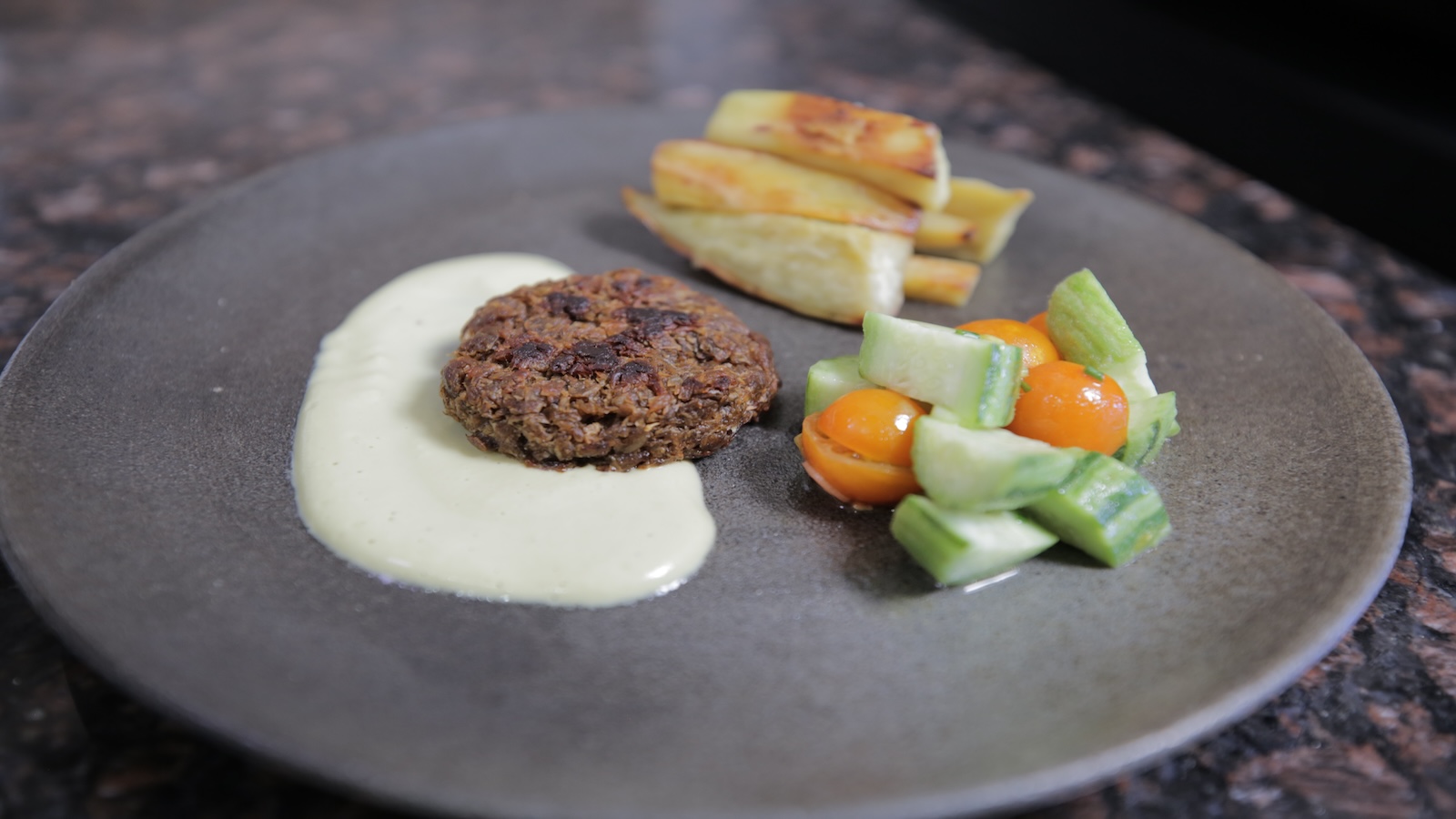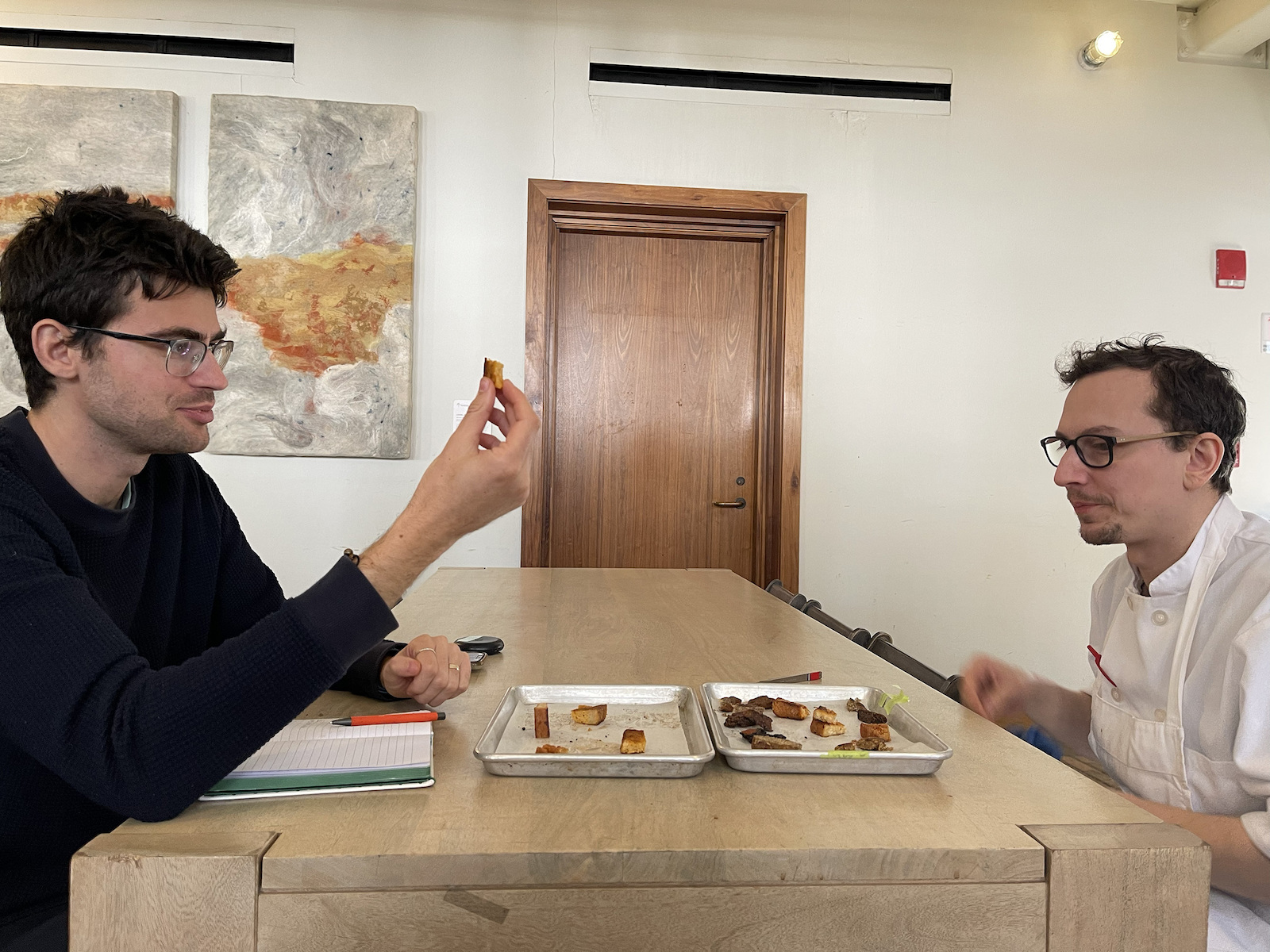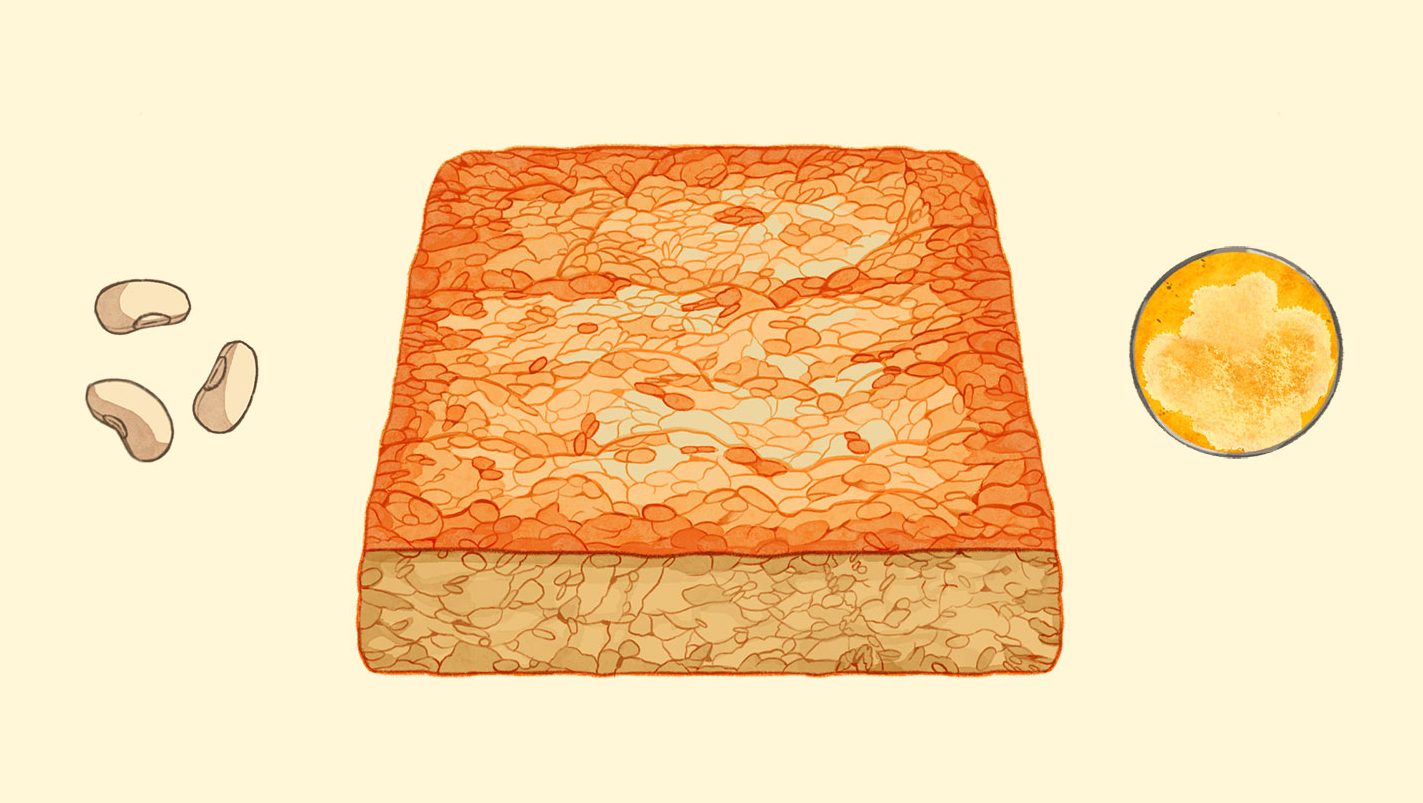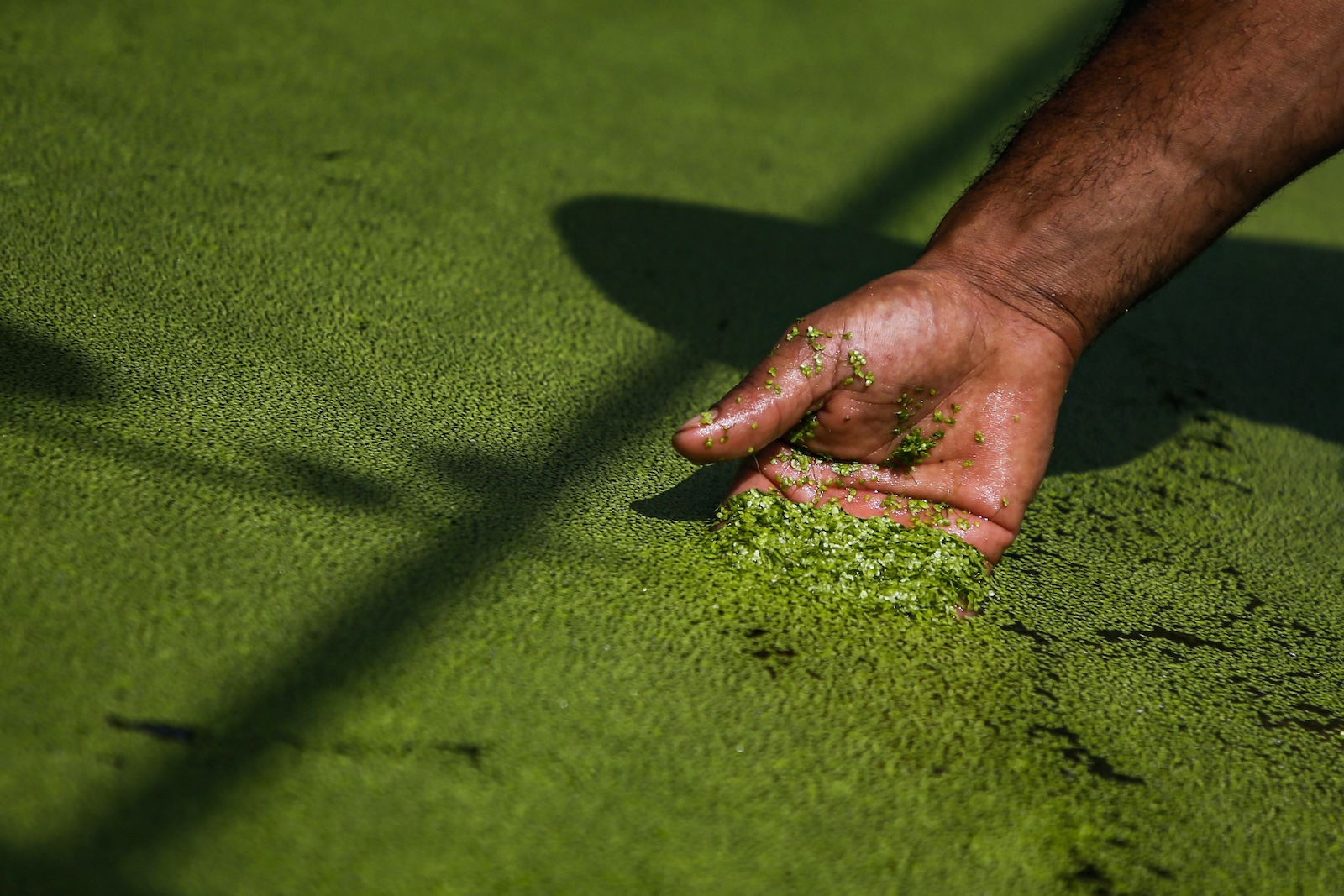Making oncom is almost magical. It starts with a pile of soy pulp, which is wrapped in banana leaves and sprinkled with the spores of a fungus called Neurospora intermedia. The bundle is left to ferment in a warm, humid place for about a day and a half. As the mold digests the proteins and starch within the fibrous pulp, it also breaks down the cellulose, turning what remains into a dish beloved by many across western Indonesia.
“It’s pretty astonishing,” said chef-turned-bioengineer Vayu Hill-Maini. “In just 36 hours, this fungal growth is really kind of transforming what otherwise is pretty inedible.”
He hopes others see it that way, too. In a recently published paper in Nature Microbiology, the Stanford University assistant professor made a convincing argument that fungal fermentation of food waste and agricultural byproducts could be the next culinary frontier.
For Hill-Maini, this is about more than making trendy dishes. It’s about improving food sustainability and reducing hunger worldwide. The process he is so excited about has been doing exactly that for centuries in parts of Indonesia, where oncom, a traditional staple, is an affordable and nutritious alternative to animal protein.

Patrick Farrell / UC Berkeley
Stir-fried; used as a stuffing, filling, or basis of sauce; and even served as a fried snack, oncom is traditionally made by combining a bit of old oncom with something like soybean pulp and leaving it to ferment. It’s much like making miso, and results in a protein similar to tempeh. Its prevalence in Southeast Asian cuisine inspired Hill-Maini, who once worked as a chef, to investigate the spore-bearing organisms behind the dish and figure out how the fungus that creates it could be embraced worldwide.
Fermentation has been around for thousands of years. It is what makes beer and wine possible, and has long been used to whip up kitchen-table fixtures such as kimchi, sauerkraut, and yogurt. It’s even behind kombucha and sourdough bread. But it turns out this chemical process, in which bacteria, molds or yeasts break down sugar to create simpler compounds, could help alleviate the mounting crisis of food waste. Hill-Maini thinks it could do that, in theory, by turning waste generated during the production of plant-based milks into inexpensive and highly nutritious dishes, helping rein in a key source of the greenhouse gas emissions generated by the world’s food system.
“We’ve known for many years that fungi are nature’s degraders,” said Hill-Maini, noting that fungi used to reduce streams of food waste could be the “most efficient way to convert waste into human food.”
Hill-Maini’s paper is the result of three years of investigating just where N. intermedia could grow, and whether it could turn the cast-offs and refuse of industrial food processing into something people would want to eat. After analyzing everything from coffee grounds to orange peels — some 30 things in all — he and his team discovered that the strain of fungus grows on most everything they tried. They also found it didn’t produce mycotoxins, the potentially deadly substances associated with some fungi.
And, perhaps most notably, it resulted in the creation of foods that repurpose what might otherwise end up in the garbage without sacrificing taste in the interest of altruism. Equally important, he wanted the process widely accessible.
“This is industrial-scale. It’s not compost bins and home kitchens. It’s massive industries that generate food-waste-grade products every single day,” said Hill-Maini.
The research focused particular attention on what’s left behind during the production of plant-based dairy, produce, and brewing. Interestingly enough, Hill-Maini discovered many of these inedible items could be transformed into something with appetizing colors, textures, and flavors.
This could be a boon for the climate, because evidence suggests every metric ton of wet waste that is upcycled through fermentation — in this case, turned into dinner instead of landing into methane-spewing landfills — prevents the release of about 600 kilograms of CO2. Before long, Hill-Maini would like to see fungal fermentation incorporated into food manufacturing facilities and any emerging refuse immediately transformed by mold.
But what really fascinates him are the climate benefits N. intermedia could provide. “What we’re thinking is we can convert this waste into protein, and then that protein can reduce animal consumption,” said Hill-Maini. “We might be able to have a massive impact.”
Drumming up enough U.S. consumer interest in food made from waste will require a pitch that goes beyond the increasingly futile message “this is better for the planet.” But that kind of branding may not be necessary. Rick von Hagn, who has spent the last few years experimenting with N. intermedia at Blue Hill at Stone Barns, says the taste and texture of this ancient way of cooking may do the trick on its own. The farm-to-table restaurant in Tarrytown, New York, has begun serving fungus-fermented foods in a handful of dishes.
His journey with the spore started in 2022, when he and colleague Andrew Luzmore began collaborating with Hill-Maini, identifying various kitchen waste streams that might be good candidates for fermentation. They’d ship something to the bioengineer, who would send back a fermented food, the first of which began as “the press-cake that’s left when you make flaxseed oil,” said Luzmore. “I remember taking out what looked like a burger patty and placing it in a hot pan. As it cooked it started looking like a well-seared steak.”
They’ve since discovered that combining the fungus with a wide range of ingredients provides a texture and flavor additive that can transform even the trickiest alt-protein dishes into a culinary star. The two chefs have used N. intermedia to improve the texture of sausages made with a mixture of meat and grains or vegetables, and brought rock-hard bread “back to life” by fermenting it with the fungus and keeping it out of local landfills. The rejuvenated bread “has the texture of French toast and the flavor of grilled cheese.” As it ferments, N. intermedia takes on an “earthy, floral quality,” von Hagn noted, and cooking it provides “a cheesy, deeply savory, mushroom-y flavor and aroma.”
Using the fungus in dishes has been such a hit with customers that the team at Blue Hill has built its own microbiology lab to evaluate the potential of fermenting various things and developing recipes with them. It is, as Luzmore described it, “a key to a whole new set of possibilities that have largely remained unexplored beyond its traditional use in Indonesia.”
Matthew Kammerer, executive chef at The Harbor House Inn in Elk, California, loves that idea. “Any cooking that’s done with byproducts or turned into something unique to limit food waste is something I’ll always definitely support,” said Kammerer, who has not been involved with the research project.
For the last seven years, Kammerer has been working with koji mold, or Aspergillus oryzae, which is widely used in Japanese cuisine to ferment soybeans and make things like soy sauce and miso. In the last decade, “koji’s kind of been the star of the show, but it seems like a very similar process and technique,” said Kammerer. He’s interested in learning more about N. intermedia’s gastronomic potential, which he dubs “far less mainstream.”
All told, it’s not just fine-dining restaurants in the U.S. that can be found embracing the culinary novelty of this Indonesian technique. Hill-Maini is now collaborating with San Sebastián, a Michelin-starred restaurant in Spain, with the aim to develop alcoholic beverages using N. intermedia. Chefs at Alchemist, a Michelin-starred restaurant in Denmark, have created a dessert in which its fungal enzymes enhance the sweetness and flavor of a sugarless rice custard.

Vayu Hill-Maini / UC Berkeley
The biggest barrier to the adoption of this strain of fungus is the dearth of places to buy the spores needed to grow it in the U.S. In Java, the Indonesian birthplace of oncom, oncom leftovers are used much like seeds to grow a new batch of the alternative protein — a process similar to using sourdough starter to make bread. In California, Hill-Maini’s team used a lab sample of N. intermedia to carry out its research. That limited availability is one reason Luzmore and von Hagn went all-in on a microbiology lab, while Hill-Maini is building a kitchen alongside his laboratory at Stanford.
Of course, the steeper hurdle is getting people to eat something that many view as garbage.
“There’s a few things working against us. We’re talking about waste, we’re talking about mold. If you say ‘mold-fermented waste,’ I think people will be really turned off and disgusted,” he said. That’s where having fine-dining chefs can help flip people’s aversion to inclination.
The irony is fermented food products, like sourdough, and those rife with fungi, such as blue cheese, have long reigned over the food scene in the U.S. Kombucha — the beloved moldy, fermented drink that hit astronomical popularity in recent years but was first brewed millennia ago — is one such success story. Hill-Maini hopes to see a similar kind of rocket-like trajectory for N. intermedia.
Embracing a food-waste-fighting fungus on kitchen tables and restaurant plates across the world is not the future of food, said Hill-Maini, but the present. “Look, this is happening in Indonesia. It’s happening in the U.S. in various ways,” he said. “This is just a new way to look at it, towards planetary health.”
He and his team aren’t re-inventing the wheel, but rolling it into a new part of the world as a force for planetary good. One discarded pile of oat pulp or moldy loaf of bread, at a time.



